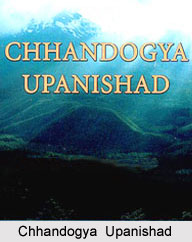 Chandogya Upanishad is one of the oldest Upanishads written on the Vedic Brahmana period about ninth to eighth century BC. Chandogya Upanishad is associated with Sama Veda. It is the part of Chandogya Brahaman that contains ten chapters. The 10th Khanda of Chandogya Upanishad states about the various paths followed after death. According to it one who is aware of the origin of the Purusha and worship God with faith and austerities in a desert, move from death to light, from day to the bright half of the moon, from the bright half of the moon to the six months. At this time the sun moves towards the north, then to the year, from the year to the sun, from the sun to the moon, from the moon to lightning. Finally he unites with the Supreme Brahman. This is known as the path of the Gods (Devayana). On the other hand one who resides in the village and accomplish their religious duties by the performing sacrifices (ishta), by undertaking social works like making of tanks, wells, halting places, and engage in charity work beyond the boundary of the altar (datta), are borne, after death. They move from darkness to the night; from the night to the dark fortnight; from the dark fortnight to the six months. At this time the sun moves towards the southern side. From the six months of the winter solstice they do not attain reach the year. From those months they go to the World of the Manes, from the world of the Manes to the akasa, from the akasa to the moon. That moon is the king Soma. They are the food of the gods. The gods do eat them.
Chandogya Upanishad is one of the oldest Upanishads written on the Vedic Brahmana period about ninth to eighth century BC. Chandogya Upanishad is associated with Sama Veda. It is the part of Chandogya Brahaman that contains ten chapters. The 10th Khanda of Chandogya Upanishad states about the various paths followed after death. According to it one who is aware of the origin of the Purusha and worship God with faith and austerities in a desert, move from death to light, from day to the bright half of the moon, from the bright half of the moon to the six months. At this time the sun moves towards the north, then to the year, from the year to the sun, from the sun to the moon, from the moon to lightning. Finally he unites with the Supreme Brahman. This is known as the path of the Gods (Devayana). On the other hand one who resides in the village and accomplish their religious duties by the performing sacrifices (ishta), by undertaking social works like making of tanks, wells, halting places, and engage in charity work beyond the boundary of the altar (datta), are borne, after death. They move from darkness to the night; from the night to the dark fortnight; from the dark fortnight to the six months. At this time the sun moves towards the southern side. From the six months of the winter solstice they do not attain reach the year. From those months they go to the World of the Manes, from the world of the Manes to the akasa, from the akasa to the moon. That moon is the king Soma. They are the food of the gods. The gods do eat them.
After remaining there for some time in the lunar world till the effects of their actions last, they return by the road to be prescribed. They reach the akasa and from the akasa to the wind; after becoming wind they become smoke, and from the smoke the scattered cloud is formed. Having become the clouds they become condensed or raining clouds. These then fall down as rain. They are then born as rice, corn, annuals, trees, sesame, lentils and the like. Now, verily it is difficult, to descend there from. Those who eat rice and procreate, become manifold. Those whose conduct is good quickly attains to some good existence, such as that of a Brahmin, a Kshatriya or a Vaishya. However, whose actions are viciously disposed assumes the form of some inferior creature; such as that of a dog, a hog, or a Chandala.
Those who neither practise meditation nor perform any rituals are born as small or insignificant creatures that keep revolving about through the cycle of birth and death. They are born and they die. This is the third place or `receptacle.` This is the reason that world never becomes full. As per a verse of this khanda a robber of gold, the drunkard who drinks spirit, the defiler of his master`s bed, and the murderer of a Brahmin are debased and filthy hence he also becomes a part of these four. A person, who knows the five fires, never becomes affected by sin, even if he associates with these vicious people. He remains pure and holy and of virtuous region.












